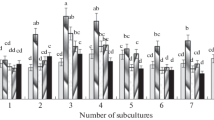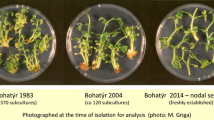Summary
Meristem tips of an Italian cultivar were cultured in a modification of Murashige and Skoog's medium.
Light spectrum and intensity affected rooting and vigour of plantlets. The best results were obtained with 4000-lux fluorescent lamps with a spectrum roughly similar to that of daylight but richer in red. Agar did not affect the proportion of explants rooting but changed the root system appearance. The presence of gibberellic acid was important for rooting. Rooting of plantlets cultured on liquid substrates devoid of gibberellic acid was not dependent on the size of the explants.
Sometimes teratomata developed in liquid substrates and occurred together with a small downward pH shift, while the normal development was always accompanied by a stronger pH shift to acid values
Zusammenfassung
Es wurden einige Faktoren, die die Entwicklung von Meristemspitzen der Kartoffel beeinflussen, untersucht. Meristemspitzen des italienischen KultivarsRicciona di Napoli wurden auf einem abgeänderten Murashige & Skoog-Medium angezogen. Die Versuche wurden während fünf Monaten, September bis Januar, durchgeführt. Das Lichtspektrum beeinflusste Bewurzelung und Wuchskraft der Pflänzchen (Tabelle 1). Fluoreszenzlampen mit einem annähernd gleichen Spektrum wie das Tageslicht, aber reicher an roten Strahlen, ergaben die besten Resultate. Die Lichtintensität war ein sehr wichtiger Faktor für die Wuchskraft der Pflänzchen (Tabelle 2); bei 4 klx (kilolux) erzeugten die Pflänzchen normale Blätter und ein gut entwickeltes Wurzelsystem, während eine Beleuchtung von 2 klx nur ein schwach oder nicht entwickeltes Wurzelsystem und eine geringe Blattausdehnung bewirkte (Abb. 1). Agar hatte keinen Einfluss auf die Bewurzelung, aber es veränderte das Wurzelbild: auf flüssigen Nährlösungen kultivierte Meristemspitzen erzeugten ein gut entwickeltes Wurzelsystem und kräftigere Pflanzen als solche auf Agar-Nährboden (Tabelle 3, Abb. 2). Das Vorhandensein von Gibberellinsäure (GA3) war für die Bewurzelung sehr wichtig, obwohl einige Pflänzchen auch auf Nährboden ohne GA3 wuchsen (Tabelle 3). Die Bewurzelung von Pflänzchen auf flüssigen Nährlösungen ohne GA3 war nicht von der Grösse der Meristemstücke anhängig (Tabelle 4); es bestand kein gesicherter Unterschied in der Bewurzelung zwischen den Meristemspitzen mit zwei Primordial-Blättchen und jenen mit vier Blättchen. Manchmal entwickelten sich in den flüssigen Nährlösungen Teratome (Abb. 3 und 4), die zusammen mit einer leichten Abwärtsverschiebung des pH auftraten, während die normale Entwicklung stets von einer stärkeren pH-Veranderung gegen das saure Milieu hin begleitet war.
Résumé
Les auteurs ont recherché les facteurs affectant le développement de pointes méristématiques de pomme de terre. Ils ont cultivé des sommets méristématiques de la variété italienneRicciona di Napoli sur un milieu de Murashige et Skoog modifié. Les essais se ont étendus sur une période de cinq mois, de septembre à janvier. Le spectre de lumière influence l'enracinement et la vigueur des plantules (tableau 1); les lampes fluorescentes avec un spectre de lumière approximativement semblable à la lumière du jour, mais enrichi en rayons rouges, ont donné les meilleurs résultats. L'intensité lumineuse constitue un facteur très important de la vigueur des plantules (tableau 2): 4 klx (kilolux) donnent des plantules montrant des feuilles normales et un système radiculaire bien développé, tandis qu'avec 2 klx, le système radiculaire est peu ou pas développé et le développement foliaire réduit (fig. 1). L'agar n'influence pas l'enracinement mais modifie l'aspect du système radiculaire: les sommets méristématiques développés sur substrats liquides produisent un système radiculaire bien développé et des plantes plus vigoureuses que celles qui poussent sur substrats agar (tableau 3, fig. 2). La présence d'acide giberellique (GA3) s'est révélée importante pour l'enracinement, bien que quelques plantules se sont développées sur des substrats qui n'en contenaient pas (tableau 3). L'enracinement de plantules cultivées sur substrats liquides dépourvus d'acide giberellique ne dépend pas du volume des ‘explants’ (tableau 4): aucune différence significative ne s'est révélée dans l'enracinement entre les pointes méristématiques portant deux ébauches foliaires et des pointes méristématiques portant 4 ébauches foliaires. Quelquefois des formations tératologiques se sont développées dans les substrats liquides (fig. 3 et 4) et se sont manifestées en même temps qu'une faible augmentation du pH, tandis que le développement normal a toujours été accompagné d'une évolution du pH plus marquée vers les valeurs acides.
Similar content being viewed by others
References
Butenko, R. G., 1968. Plant tissue culture and plant morphogenesis. Israel Program for Scientific Translation Ltd, Jerusalem.
Gautheret, R. J., 1969. Factors affecting differentiation of plant tissues grownin vitro. In: Cell differentiation and morphogenesis (International Lecture Course, Wageningen, the Netherlands, 26–29 April 1965). North-Holland Publishing Co., Amsterdam.
Hollings, M., 1965. Disease control through virus-free stock.A. Rev. Phytopath. 3: 367–396.
Hollings, M. & O. M. Stone, 1968. Techniques and problems in the production of virus-tested planting material.Sci. Hort. 20: 57–72.
Jones, R. L. & I. D. J. Phillips, 1966. Organs of gibberellin synthesis in light-grown sunflower plants.Pl. Physiol. 41: 1381–1386.
Kassanis, B., 1967. Plant tissue culture. In: K. Maramorosch and H. Koprowsky (Ed.), Methods in virology, Vol. 1. Academic Press, New York/London.
Kassanis, B. & A. Varma, 1967. The production of virus-free clones of some British potato varieties.Ann. appl. Biol. 59: 447–450.
Mellor, F. C. & R. Stace-Smith, 1969. Development of excised potato buds in nutrient culture.Can. J. Bot. 47: 1617–1621.
Morel, G., 1964. Régéneration des varietés virosées par la culture de méristèmes apicaux.Rev. Hort. 261: 733–740.
Morel, G. & C. Martin, 1955. Guérison des pommes de terre atteintes de maladie à virus.C.r. hebd. Séanc. Acad. Agric. Fr. 41: 472–475.
Morel, G., C. Martin & J. F. Muller, 1968. La guérison des pommes de terre atteintes de maladies à virus.Annls Physiol. végét. 10 (2): 113–139.
Murashige, T. & F. Skoog, 1962. A revised medium for rapid growth and bio-assays with tobacco tissue culture.Physiol. Plant. 15: 473–497.
Norris, D. O., 1954. Development of virus-free stock of Green Mountain potato by treatment with malachite green.Aust. J. agric. Res. 5: 658–663.
Pennazio, S., 1971. Terapia di virosi della patata (Solanum tuberosum L.): coltura di apici meristematici abbinata a termoterapia.Riv. Ortofrutt. ital. 5: 446–452.
Phillips, D. I., 1969. Carnation shoot tip culture. Tech. Bull. 102: 1–22.
Reid, D. M. & J. B. Clements, 1968. RNA and protein synthesis: prerequisites of red light-induced gibberellin synthesis.Nature, Lond. 219: 607–609.
Reid, D. M., J. B. Clements & D. J. Carr, 1968. Red light induction of gibberellin synthesis in leaves.Nature, Lond. 217: 580–582.
Stace-Smith, R. & F. C. Mellor, 1968. Eradication of potato virus X and S by thermotherapy and axillary bud culture.Phytopathology 58 (2); 199–203.
Steward, F. C. & A. D. Krikorian, 1971. Plant, chemicals and growth. Academic Press, New York/London.
Stone, O. M., 1963. Factors affecting the growth of carnation plants from shoot apices.Ann. appl. Biol. 52: 199–209.
Street, H. E., 1969. Growth in organized and unorganized system. In: F. C. Steward (Ed.), Plant Physiology: a treatise, Vol. VB. Academic Press, New York/London.
Author information
Authors and Affiliations
Rights and permissions
About this article
Cite this article
Pennazio, S., Redolfi, P. Factors affecting the culture in vitro of potato meristem tips. Potato Res 16, 20–29 (1973). https://doi.org/10.1007/BF02360589
Accepted:
Issue Date:
DOI: https://doi.org/10.1007/BF02360589




